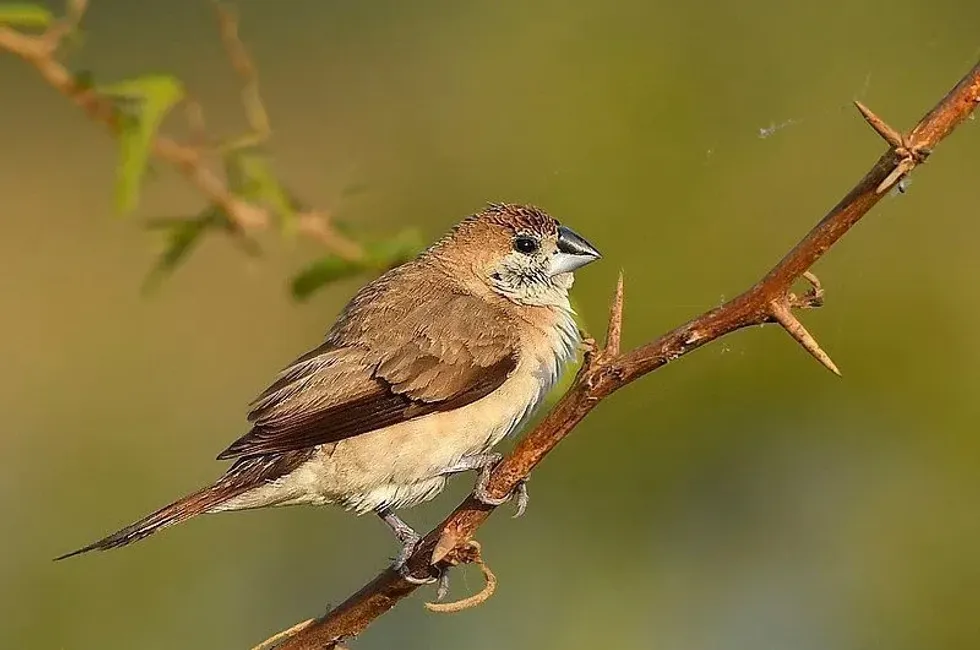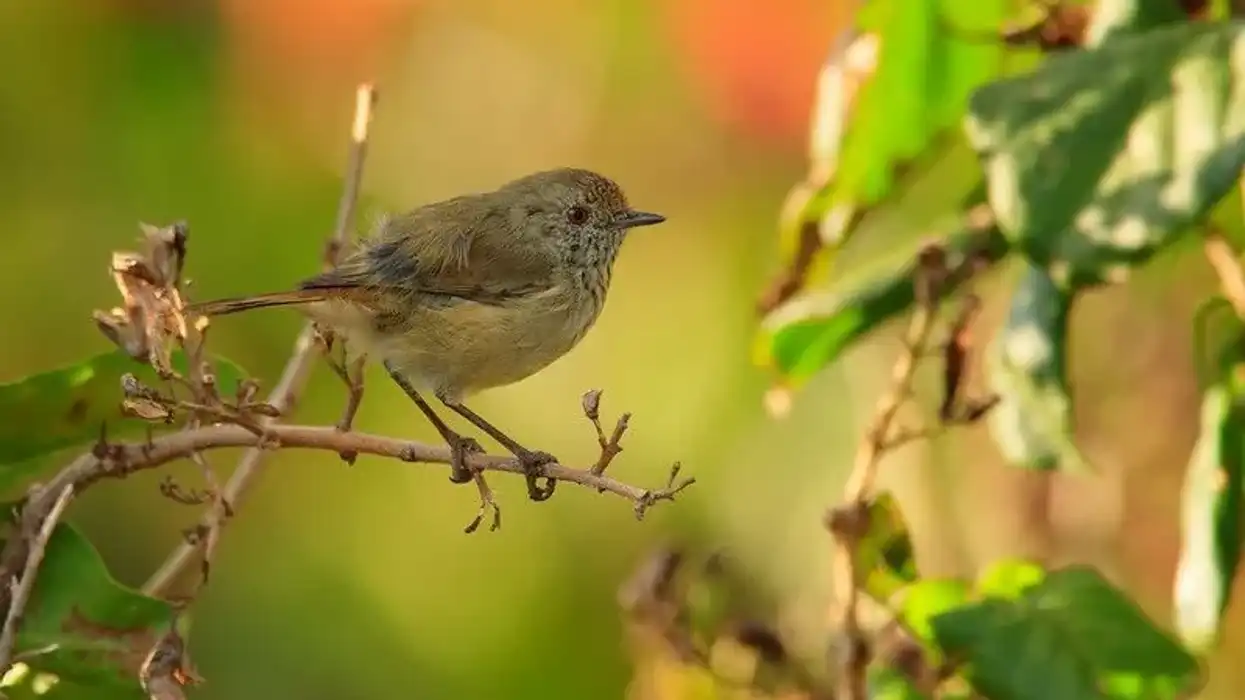Are you fascinated by finches? Then here we have all the information on the Indian silverbills. The Indian silverbill (Lonchura malabarica) is a species of finch bird, which is also known as the white-throated munia.
The Indian silverbill appearance is quite plain and simple. These munias have brownish-buff flanks along with the dorsal side and a white ventral side. Their tail is black and wings are dark which sets a nice contrast of colors with their white rump.
This white rump is clearly visible when they are in flight or when they are sitting. They have pale grayish-brown to red-colored legs and a silver-gray-colored pointed bill. They feed on seeds, nectar, and small invertebrates.
They mainly eat seeds of sedges, grass, or rice. These birds are closely related to the African silverbills and are even considered as conspecifics. They are named so because of their silver colored bills.
While you search for these birds, start reading on! You can also learn more about a variety of other birds and can start your ornithological adventure with birds like the pileated woodpecker and the Arizona woodpecker.
Indian Silverbill Interesting Facts
What type of animal is an Indian silverbill?
Indian silverbill finch is a species of passerine bird, like the Gouldian finch.
What class of animal does an Indian silverbill belong to?
The Indian silverbill (Lonchura malabarica) belongs to the class Aves of animals.
How many Indian silverbills are there in the world?
The population of these birds in an exact number is not known. However, they have been reported as a common species throughout the local Indian silverbill range. The population trend has also seemed to be stable.
Where does an Indian silverbill live?
This bird occurs only in a few parts of South Asia. They can be seen in east Oman, Qatar, south Iran, United Arab Emirates, and east Saudi Arabia eastwards along the coast of the Indian subcontinent.
They live in the southern parts of the Himalayas from Nepal and Pakistan to southwards to Sri Lanka and eastwards to Bangladesh. They can also be found in Kuwait and northwest Arabia.
The Indian silverbill in France, Virgin Islands, Hawaiian Islands, and Puerto Rico are introduced birds. They are not migratory, rather resident birds with only moving locally from one place closely to another.
What is an Indian silverbill's habitat?
The primary Indian silverbill habitat consists of open country areas. They can be found in urban areas and villages, dry open woodlands, semi-desert, and scrub, sometimes near water, and areas of cultivation.
They are generally found in both hills and plains within an elevation of 0.4 mi (600 m). In the sub-Himalayan areas, they can be seen up to an elevation of 0.7 mi (1200 m).
Who do Indian silverbills live with?
Indian silverbills are gregarious. They can be seen in small or large flocks. They are found in large flocks in early winter and late monsoon.
How long does an Indian silverbill live?
The exact lifespan of these finch birds is not known. However, estrildid finches like this silverbill bird species, red-headed finches, and more birds, in general, are known to live for only about 4-7 years on average.
How do they reproduce?
The breeding season of this bird occurs year around depending on their geographic distribution. The breeding season generally arrives with the arrival of monsoon, but in the Indian subcontinent, it occurs during winter.
During courtship behavior, the Indian silverbill male bird can be seen singing, stretching, and twisting towards the Indian silverbill female bird. The male bird grabs a stem and drops it near the female bird.
It starts bobbing its head up and down while standing erect with the tail pointing down. Then turns and points its tail towards the female while bobbing its head up and down. Then the male starts to sing and bob up and down by bending and stretching its legs.
After copulation, the female lays about three to eight eggs on average. The Indian silverbill eggs are then incubated for the next 12 - 14 days.
The chicks leave the nest and become independent after about 21 - 23 days. Not much is known about the parental care done by the adults.
What is their conservation status?
The conservation status of these birds according to the International Union for Conservation of Nature is listed as Least Concern. They are not facing any great threats to their population, so no conservation actions have been planned or taken yet.
Indian Silverbill Fun Facts
What do Indian silverbills look like?
The Indian silverbill (Lonchura malabarica) is a small-sized bird species. In general, the ventral side of these birds is white and the dorsal side is buffy brown colored. They have dark wings, a pointed tail, and a cone-shaped silver-gray colored bill.
The plumage of white Indian silverbill feather starts from beneath their bill, extends through their throat, breast, belly to their under tail. They have brownish-buff-colored flanks and a white rump.
This white rump becomes conspicuous sometimes when they are sitting and always in flight. Feathers of their wings are dark-colored, while their central tail feathers are elongated and black and upper tail coverts are white. The legs are usually pale grayish-brown to deep red-colored.

How cute are they?
These little birds can look extremely adorable with the beautiful white and buff colors of their plumage, just like a finch. In addition, these birds are not known to be aggressive at all. Surely it's a charming addition to their cuteness.
How do they communicate?
These birds communicate visually and vocally. The calls of the male and female birds are different. The call of the female sounds like a double-noted 'tsiptsip' which can sometimes be heard with each note sharply separated.
The call of the male sounds like a loud 'tseep'. Their song is very similar to their closely related species, the African silverbill (Lonchura cantans). It's a quickly repeated trilling series of notes that first rise and then fall.
How big is an Indian silverbill?
An adult Indian silverbill is about 4.3 in (11 cm) in length. They are slightly smaller than house finches. An adult house finch is about 5-6 in (12.5-15 cm) in length.
How fast can an Indian silverbill fly?
The exact speed at which these birds fly is not known. However, they have been seen to fly at a moderate pace.
How much does an Indian silverbill weigh?
These are small-sized birds. An adult Indian silverbill is about 0.3-0.5 oz (10-14 g) on average.
What are the male and female names of the species?
The males of the species are known as cocks and the females of the species are known as hens.
What would you call a baby Indian silverbill?
A baby Indian silverbill is known as a chick or a hatchling.
What do they eat?
These birds are omnivorous in nature. For plant matters, they feed on seeds of cultivated millet, sedges, grass, and rice. Sometimes they have been seen feeding on nectar from flowers. In animal-based food, they mainly feed on insects, like mayflies, crickets, bugs, and more. They have primarily been seen to forage on the ground.
Are they poisonous?
This bird is not poisonous at all. They are also not aggressive or dangerous in any other way towards humans or other animals.
Would they make a good pet?
These are beautiful small sweet-sounding birds. People have come to keep finches as pets for a long time.
Similarly, even though now it's almost impossible to see Indian silverbills being kept as pets, in the 1800s and 1900s, people did domesticate these birds. You can keep them as pets, but remember to replicate their requirements in their wild habitat in a good manner.
Did you know...
The nest of this bird is made by females and the materials needed are provided by males. These nests are usually round-shaped with a hole to enter and exit at one side. These nests are made with grass, straws, and twigs and are lined with feathers. These nests are usually made about 6.6-9.8 ft (3-4 m) above ground level.
What's unique about an Indian silverbill?
The most unique things about these birds are their short, cone-shaped silver-gray colored bill and their sweet song. This distinctive bill, which is their specialty and their geographic distribution, gives them their common name, 'Indian silverbill'.
Are Indian silverbills endangered?
No, Indian silverbill bird is not Endangered at all. They are rather common in many parts throughout their habitat range. They have a stable population and are not facing any great threats to their population.
Here at Kidadl, we have carefully created lots of interesting family-friendly animal facts for everyone to discover! For more relatable content, check out these common goldeneye facts and blackpoll warbler facts for kids.
You can even occupy yourself at home by coloring in one of our free printable bird coloring pages.
The hero image is by Savitri Singh and the second image is by Davidvraju.










